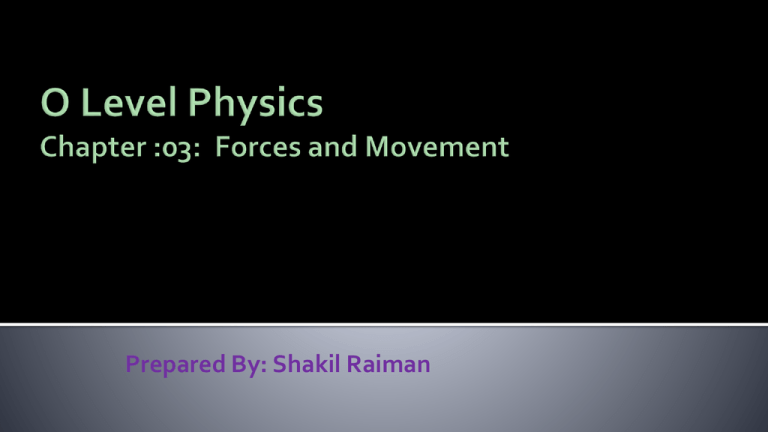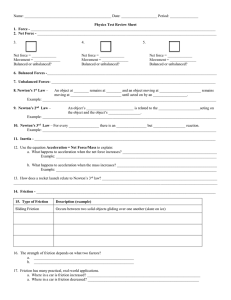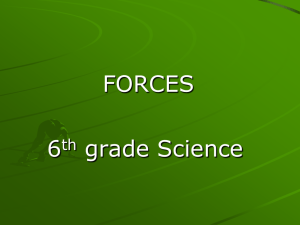O Level Physics Chap 03 Forces and Movement
advertisement

Prepared By: Shakil Raiman First Law: If there is no unbalance force – a stationary object will remain stationary and a moving object will keep on moving at a constant speed in a straight line. Second Law: The unbalanced force is directly proportional to the rate of change of momentum. Direction of the change in momentum is same as the direction of unbalanced force. Third Law: To every action force there is an equal and opposite reaction force. Only unbalanced force can cause the acceleration. In the formula, F = ma , F = unbalanced force , m = mass of an object a = acceleration In the formula, F – f = ma F = applied force f = opposing forces ( friction or air resistance) Therefore, F – f = unbalanced force Weight W = mg Friction is a contact force. Friction always decreases the efficiency of any engine. Friction always decreases the speed of a moving car that means it works as opposing force to the motion. Advantages and Disadvantages of friction are given below: Advantages Disadvantages to hold an object reduces the efficiency of any engines for the movement of any car or animal tear or wear the moving parts (tyres of car) Negative effect of friction can be reduced by: Making the surface smooth Lubricating Using ball bearings. Friction is less in wet surface. As friction is less in wet surface the breaking distance will be more. In wet surface deceleration decreases. Distance travelled during thinking is known as thinking distance. Thinking distance is affected by drivers reaction time and speed of the car. If the driver is drunk, sleepy or tired the thinking time increases So the thinking distance increases Distance travelled after the brake is applied. Braking distance depends on the speed, road condition, and tire or brake condition. Braking distance increases if the speed increases, if the road is wet or icy, there is less grip or friction so braking distance increases, if the tire is old, there is less grip or friction. So braking distance increases Stopping Distance = Thinking distance + Braking distance Initially only weight acts downward. So, object accelerates downward. As the speed of the object increases, air resistance increases. So, unbalance force decreases. So, acceleration decreases. At a point, air resistance becomes equal to the weight. Unbalanced force become zero. So no acceleration occurs. Object reaches terminal (constant final) velocity. drag force depends on shape of the falling objects. If the smooth or streamlined the drag force will be less. Parachute increases the air drag (resistance) very much and reduces terminal speed. Wish you all very good luck and excellent result.





